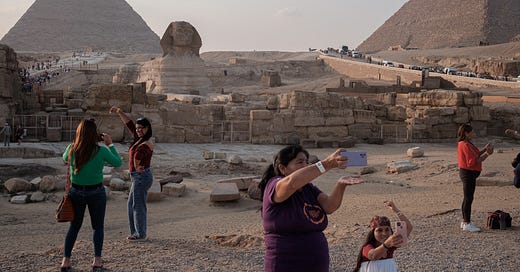The photograph is two-dimensional, but you might be forgiven to think it is not. The distribution of the women in the foreground is almost circumambient; they are seen from the side, back, and front. One pyramid, also seen from the side, seems hexagonal in form, as though by a slight glance to the right you can take in the sight of the entire edifice. There is a trail of cars and people on either flank of the background, with the towering, ancient statue in the centre. Thus the perspectives—of the admiring crowd and the unfazed stones—are as discordant as an untrained mass choir. Each person is left to decide what it means to see and be seen.
— Emmanuel Iduma
“I am always interested in people, and how my photos will be viewed 100 years from now.”
The photo was taken at the Giza Pyramids complex in Egypt where tourists take selfies with the great pyramids in the background. When I noticed all the people consumed by their phones trying to take a photo of themselves, I tried to fill all the spaces in the frame so I can portray what it feels like in that moment.
I chose this photo because I try to make my photography style more layered. It's a great challenge I am still learning to master, to create a foreground, mid-ground and a background. It's a fun exercise, but very difficult to place all the elements in a split-second decision.
I am always interested in people, and how my photos will be viewed 100 years from now. So I try to include people's behaviour and fashion trends in my photos. The background is always present, as I try to draw a complete picture of that moment in time.
— Aly Hazzaa
About Aly Hazzaa
Aly Hazzaa is a street and documentary photographer from Cairo, Egypt. He has explored the streets with his camera since 2003, capturing the beauty and diversity of life in his city. In 2011, he left his engineering career and became a full-time photojournalist for Al Shorouk, an Arabic-language newspaper in Egypt, covering various events from portraits to protests and conflicts, but continutes to work as a street photographer. Find out more about his work on his website, Instagram, and via this Fujifilm story.
LAST WEEK
— “Gambia'Barra: On Memory,” by Adïam Yemane
Mesmerized by the body of water and the warm golden light of the early hours reflecting off it, I kept thinking about the people who had crossed these same waters around 300 years ago, being carried away into slavery, unsure if these same waters would ever see them return. Observing the people who now willingly commute on the same waters, I try to look for signs of liberation in their body language, what they have brought with them, how they hold these objects, the way they stand or sit on their journey, how they move and interact with each other.
— “The Distance,” in KINDRED.
By the time I took the photo, I no longer lived in New York, and scarcely found reason to commute by rail. Being on an Amtrak was thus an exception, and I thought it wise to record the American life I was seeing, as if anew.
This is the 93rd edition of this publication, which also read on web (best for viewing images), and via the Substack iOS/Android apps.
Every Wednesday I feature one photograph and the photographer who took it: you’d read a short caption from me, and a statement from the photographer. Every Friday, I publish a series of commentaries in response to photographs previously featured on the newsletter. The most recent series is KINDRED. My hope is to engage with early to mid-career African photographers, and to create a platform in which photographers lead the cataloguing and criticism of their work.
Photographers can now submit their work for consideration.
Thank you for reading. If this newsletter was shared with you, consider subscribing, or forward to a friend. Please whitelist the newsletter to ensure you never miss it.






